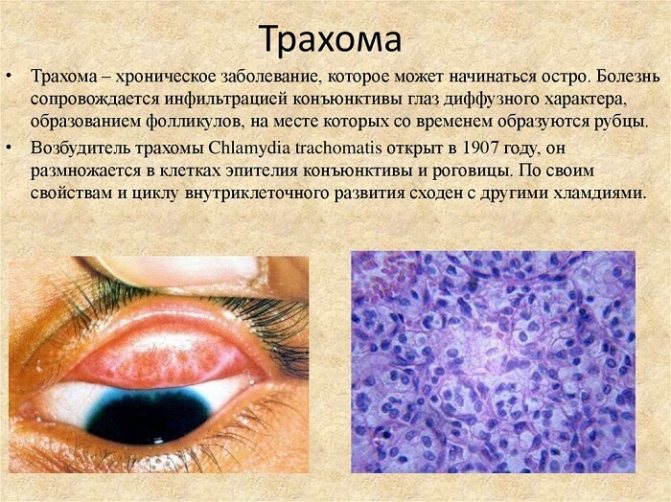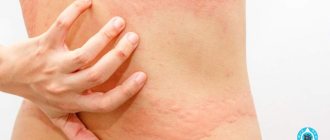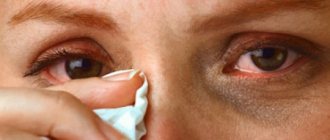What causes itchy eyelids?
The eyelids itch, turn red and swell due to the fact that an inflammatory process develops in their tissues. It can be caused by many provoking factors, the main ones being:
- use of cosmetics of inadequate quality;
- allergic reaction to components of a cosmetic product;
- acute viral infections that cause inflammation of the mucous membranes of the nasopharynx and eyes, such as influenza and ARVI;
- dry eye syndrome;
- dry air in the room where a person stays for more than 6 hours a day;
- incorrectly selected contact lenses;
- storing contact lenses using inappropriate liquid;
- entry of a foreign object into the eye, leading to microtrauma of the cornea and conjunctiva of the eye;
- long-term intense eye overload.
Also, when the eyelids itch and itch, there may be a seasonal allergy, which also manifests itself as a runny nose and general malaise.
The reason that the eyelid itches and itch may also be eye diseases. In such a situation, comprehensive treatment is required. Unpleasant sensations may be a symptom that a person has one of the following pathologies:
- demodecticosis - damage to eyelashes and eyebrows by a microscopic mite, the waste products of which cause inflammation;
- blepharitis - inflammation of the eyelids with discharge of pus. With it, itching and swelling of the upper eyelid are more often observed;
- conjunctivitis – inflammation of the conjunctiva of the eye, which initially affects the corner of the eye and gradually spreads further;
- stye is a purulent inflammation of the hair follicle of the eyelashes.
Swollen eyelids, redness, itching are symptoms of many diseases, and therefore for quality treatment it is best to contact an ophthalmologist who can provide qualified assistance.
The lower eyelid hurts and is swollen - what are the pathological causes?
In some cases, swelling of the lower eyelid is a symptom of an existing or just beginning to develop pathology. If, after a series of studies, the ophthalmologist sees the cause precisely in inflammatory processes within the body, then treatment should begin with eliminating the root cause, and in parallel, use drugs aimed at reducing swelling. Improper functioning of the kidneys or urinary system is one of the most common causes. In addition to swelling, the child has a frequent urge to urinate and spastic pain in the lower back. With cardiac diseases, which are also the cause, the lower eyelid most often swells in the evening. The clinical picture of this type of pathology is complemented by swelling of the legs, arms, and heavy breathing. Liver disease can cause the lower eyelid to swell. At the same time, pain appears under the right rib and the color of the skin changes. Diseases of an ophthalmological nature, which result in swelling of the lower eyelid, should be included in a separate group.
These include: conjunctivitis, blepharitis, chalazion. The appearance of allergies, especially seasonal runny nose, is accompanied by increased production of tears and, as a result, leads to the eyelid becoming swollen and itchy, and even red. To eliminate this manifestation, it is very important to eliminate the allergen that triggers the reaction.
How to relieve itching due to allergies
If the cause of the discomfort is an allergic reaction, the easiest way to solve the problem is. In this condition, in order to eliminate itching and swelling of the upper or lower eyelid, you should first take an antiallergic drug. Such time-tested remedies as suprastin, citrine and tavigil help well. They begin to act quickly (within 10-15 minutes) and almost never cause side effects.
For topical use, to relieve itching, you can use drunk green tea without any additives. For the procedure, still warm tea bags are applied to the eyelids and lie with them until the itching goes away. Usually, improvement begins to appear within 5-7 minutes.
In cases where the eyelid itches and itches due to an allergic reaction to a cosmetic product, it should be completely abandoned, even if it is of high quality and expensive. Each person’s body is individual, and therefore not always even good components in personal care products can be tolerated by the skin.
Important! It is unacceptable to use expired cosmetics, as they especially easily cause inflammation due to the accumulation of pathogenic bacteria in them.
Foreign body entry
The smallest speck that sticks to the mucous membrane of the eye or gets under the eyelid can become a source of continuous itching and irritation in the eye area. You can remove dust, sand, construction or street debris at home by rinsing your eyes in a small tray or bath: dip your eye in water and blink several times. You can try to wash the speck with running water at room temperature, but you should use low pressure so as not to injure your eyes with a strong stream.
To prevent inflammation, it is recommended to instill any of the antibiotics:
But if the feeling of discomfort, pain and burning does not go away, you should see an ophthalmologist: sometimes foreign particles stick tightly to the surface of the mucosa and cannot be removed at home.
Relieving itching caused by eye strain
When dry eyelids, peeling, redness, and itching are noted due to prolonged eye overload, traditional medicine can come to the rescue. Before carrying out home therapy, you should definitely make sure that there is no eye disease, the treatment of which should be professional.
Fatty, high-quality sour cream relieves discomfort well. It should be applied in a thick layer to the eyelids and left for 15-20 minutes every evening until the skin is in good condition. For even greater effectiveness, before applying sour cream, you can wipe your eyelids with a swab dipped in cucumber juice.
It is useful when the skin on the eyelids peels and itches, using natural olive oil without impurities. This product perfectly nourishes the skin and restores its normal water balance, eliminating the problem.
When your eyelids itch and itch, it is good to use a cucumber mask. It relieves inflammation and soothes irritated skin. Before going to bed, the vegetable, grated on a fine grater, is applied to the eyelids and, covered with cotton pads, left for 20 minutes.
A mixture of cucumber juice and honey also relieves itching of the eyelids due to fatigue. The ingredients are mixed in a 1:1 ratio and, after moistening cotton pads in the resulting preparation, apply them to the eyes. Leave the compress on for 30 minutes. For severe itching, repeat the procedure in the morning and evening, and for moderate itching, repeat the procedure once.
Demodicosis
One of the most unpleasant reasons why the eyelids may itch is the introduction of a microscopic mite into the eyelashes or epidermis, which is present on the skin of 80% of people and is normally a saprophyte. However, with a decrease in immunity, it attacks the human host and turns from a neighbor into an enemy.
Demodicosis is characterized by the following symptoms:
- hyperemia of the eyelid margin;
- the eyelids begin to itch at first a little, then unbearably;
- the skin covering the eyelids peels off;
- discharge appears in the form of mucus or foam;
- eyes become red and watery;
- eyelash loss is observed;
- The patient is haunted by the feeling of a foreign object in the eye.
In the absence of timely and adequate treatment, the mite multiplies and can affect the nasolabial folds, ears, cheeks, and bridge of the nose.
Treatment of itching in inflammatory eye diseases
When the eyelids are red, swollen, itchy and peeling due to inflammation of the eyes, in addition to the treatment that is being carried out, folk therapy will also be useful to quickly relieve discomfort. Products based on medicinal herbs help relieve itching.
A decoction of calendula flowers is an excellent remedy for getting rid of itchy eyelids. A tablespoon of dried flowers in a thermos is poured into 200 ml of water, brought to a boil, and left for 20 minutes. After filtering, the resulting product should be used to rinse the affected eyes up to 6 times a day.
If the skin on the eyelids peels and itches against the background of an inflammatory process, pharmaceutical chamomile is also effective. Based on the medicinal plant, a composition similar to that obtained from calendula is prepared. Chamomile remedy is used in the same way. In pharmacies you can also buy chamomile lotion for rubbing the eyes, which is no less effective than the infusion.
When the eyelids peel and itch, the ophthalmologist determines how to treat them for inflammation. Antibiotics, such as tetracycline eye ointment, are most often prescribed to get rid of pathogenic bacteria. Antibiotic drops are also selected for the patient.
Important! It is strictly forbidden to prescribe antibiotics for eye treatment on your own, since choosing the wrong remedy can only significantly worsen your condition.
Localization of unpleasant sensations
Often, redness and itching of the eyelids does not spread over their entire area, but affects only a small area. And then knowledge of the localization of pathological sensations is enough to make a preliminary diagnosis.
Corners of the eyes
If irritation and itching are localized in the outer corner of the eye, then, first of all, the presence of conjunctivitis should be assumed. Additional symptoms confirming this diagnosis are the presence of thick, stretchy discharge, as well as cracks in the mucous membrane in the corners of the eyes.
Under the eyes
If the unpleasant sensations are concentrated under the eyes, in the area of the lower eyelid, most likely, we are talking about an incipient allergic reaction. The diagnosis will be confirmed if the patient begins to sneeze a little later, discharge from the nasal passages appears, and the eyes begin to turn red and watery.
Swollen, flaky and red eyelids: causes and treatments
The main causes of itching, irritation and redness in the eye area are infections and allergic reactions.
The eyelids become red, swollen, itchy, or flaky. Behind almost every sign lies a serious disease of the organ of vision or malfunction of the body, which the patient may not even be aware of.
Therefore, any of these symptoms that cause severe discomfort require an immediate visit to an ophthalmologist.
Symptoms and causes
Signs of illness manifest themselves differently in everyone. The main signals about problems with the eyes or internal organs are:
- swollen, inflamed, or red eyelids;
- flaky skin;
- profusely falling eyelashes;
- a feeling of cloudiness in the eye that prevents you from seeing objects clearly;
- frequent blinking;
- involuntary lacrimation;
- accumulation of pus in the corners of the eyes;
- the formation of white or yellow crusts on the eyelash line;
- itching and burning in the eye area.
These symptoms can appear at any age - in children, adults and the elderly, women and men. However, the causes of illness can vary greatly in each specific case.
One common cause of flaky, puffy, or red eyelids is an allergic reaction. Most often it is caused by low-quality decorative or skincare cosmetics. Provoking factors also include:
- house or street dust;
- pollen of flowering plants;
- household chemicals;
- certain foods;
- eye drops or ointments;
- lens treatment liquid;
- medications for oral administration;
- Sun;
- freezing.
Eyelid problems can arise for a number of other reasons. Eye diseases most often diagnosed by ophthalmologists:
- dry eye syndrome;
- blepharitis;
- demodicosis;
- conjunctivitis;
- ripening barley;
- glaucoma;
- cataract;
- incorrectly selected lenses, causing discomfort and disruption of the organ of vision.
The problem of redness and itching of the eyelids can be hidden inside the body. Such pathologies are often caused by:
- diabetes mellitus;
- metabolic disorders;
- thyroid dysfunction;
- liver or intestinal diseases;
- severe physical or mental exhaustion;
- regular lack of sleep;
- lack of vital nutrients in the body - vitamins, minerals, amino acids, etc.
If during the examination the doctor does not detect eye diseases, he will definitely refer the patient for examination to other specialists - a dermatologist, allergist, endocrinologist or gastroenterologist.
Treatment regimen
Self-medication of red, swollen and flaky eyelids can only aggravate the situation, cause a deterioration in health and a decrease in visual acuity. The recommendations below are provided for informational purposes only and do not constitute a guide to action.
Allergic reaction
When the body is hypersensitive to a particular substance, itching and redness of the eyes are usually accompanied by frequent sneezing, dry cough, runny nose, asthma attacks or lacrimation. Eliminating the problem in this case is simple - it is enough to identify the allergen and completely eliminate its negative impact.
The photo shows clear signs of an allergic reaction.
General recommendations from doctors for allergies:
- In the spring and summer, when the allergen plant blooms, stay outside as little as possible. Avoid long walks on windy days, after returning home, take a shower or wash your face and exposed areas of the body, change street clothes to home clothes.
- Carry out wet cleaning and wipe dust from all surfaces daily.
- Eliminate foods that trigger allergy attacks from your diet.
- Use hypoallergenic cosmetics. If any contact with powder, eye shadow or mascara causes redness, swelling and itching of the eyelids, completely stop using decorative cosmetics.
- If you are allergic to household chemicals, replace them with more harmless ones.
- If you are hypersensitive to sunlight, wear sunglasses regardless of the climate and time of year.
To relieve an acute attack of allergies, doctors prescribe various antihistamines (antiallergic) drugs. These can be either eye drops or tablets, capsules or syrups for oral administration.
The most effective allergy medications are listed in the table:
| Pills | Eye drops |
|
|
In certain cases, doctors supplement the complex of prescriptions with vasoconstrictor eye drops (Vizin, Okumetil, Octilia, Polinadim, etc.) and anti-inflammatory effects (Dexamethasone, Lotoprednol, Maxidex, Sofradex, Prenacid, etc.).
You may need to take enterosorbents that help quickly remove toxins and allergens from the body, for example:
- Atoxyl;
- Carbolene;
- Polysorb;
- Polyphepan;
- Smecta;
- Filtrum;
- Enterosgel.
An effective folk remedy that helps quickly relieve allergy symptoms is a solution of boric acid. You need to add 1 tsp. pharmaceutical powder in 300 ml of chilled boiled water and stir thoroughly. Rinse your eyes 3-4 times during the day.
Conjunctivitis
The infection affects children and adults with weakened immune systems. The nature of the disease can be viral or bacterial. The effectiveness of therapy depends on the correct identification of the cause of conjunctivitis.
To treat bacterial conjunctivitis, antimicrobial eye drops or ointments are prescribed:
| Drops | Ointments |
|
|
For viral conjunctivitis, the treatment regimen includes therapy for the underlying disease and the use of antiherpes drugs, tear substitutes and warm compresses.
Demodicosis and blepharitis
Both of these diseases are accompanied by similar symptoms, but have a different nature. So, the cause of demodicosis is the subcutaneous demodex mite, blepharitis is caused by fungi or bacteria.
The clinical picture of blepharitis and demodicosis of the eyelids is very similar
Treatment of infection includes a set of prescriptions and procedures:
- washing the eyes with antiseptics or boric acid solution;
- eyelid massage;
- instillation of tear substitutes;
- ozone therapy;
- magnetic therapy;
- warm compresses;
- taking vitamin and mineral complexes in tablets or capsules to improve the functioning of the organ of vision and strengthen the general immune system.
Treatment of blepharitis or demodicosis is impossible without the use of antiparasitic, antimicrobial and anti-inflammatory drugs for the eyes:
| Antimicrobial agents | Antiparasitic drugs | Anti-inflammatory drugs |
|
|
|
Treatment for blepharitis or demodicosis is not quick. Its result depends on the patient’s discipline, adherence to personal hygiene rules and complete compliance with all doctor’s recommendations.
Dry eye syndrome
This pathology is more often diagnosed in young people who are forced to look at one point for a long time and intently (typesetting operators, network administrators, programmers, computer game lovers, etc.). Dry eye syndrome also affects elderly patients whose eyes, due to age, are not able to produce a sufficient amount of tear fluid.
Treatment of red and swollen eyelids in this case is impossible without the use of special eye drops that replenish the lack of tear fluid:
- Visine is a pure tear;
- Hyphenation;
- Ophtolic;
- Ofta-gel;
- Slesin;
- Systane (balance, ultra);
- Oksial;
- Artificial tear.
To alleviate the condition of patients, doctors recommend giving the eyes a 5-10 minute rest every hour during prolonged visual stress, and using electric humidifiers in rooms with a dry climate.
Barley
A red, itchy upper or lower eyelid may be a symptom of a developing stye. The cause of the pathology in most cases is Staphylococcus aureus, which affects those who do not maintain personal hygiene or have weak immunity.
The photo shows a ripening stye that caused swelling and redness of the eyelids
To speed up the maturation and release of pus, doctors advise putting antibacterial drops or ointments into the sore eye, taking a course of UHF therapy at the clinic, or warming up the stye with a blue lamp at home.
Other reasons
When the skin in the eye area peels and dries, the eyelids swell and itch, but doctors do not diagnose any eye pathologies, the cause of the ailment is often a banal vitamin deficiency. In such cases, the condition of the skin and general well-being can only be improved by a balanced diet and additional intake of vitamin and mineral complexes.
In every pharmacy you can find all kinds of dietary supplements and multivitamin preparations, but preference should be given to those that are designed specifically to improve the functioning of the organ of vision, for example, Alphabet Optikum, Focus, Biorhythm Vision, Blueberry Forte, Vitrum Vision or Complivit Oftalmo.
Any disease accompanied by redness, itching, swelling and peeling of the skin of the eyelids requires qualified diagnosis and complex therapy.
Infectious and age-related pathologies (glaucoma and cataracts) must be treated under the strict supervision of a doctor.
Otherwise, the advanced disease will suffer for a long time, and in especially severe cases, surgical intervention will be required.
Source: //tonustela.net/skin-nail/peeling-skin/krasnye-veki.html
Why did barley appear on the cornea?
If a pimple-like inflammation has formed on the eyelid, in the eyelash growth area, which is swollen and itchy, then you can assume that you have stye. It is formed when the sebaceous glands or hair follicles are clogged, as a result of which an itchy abscess begins to form in that very place. In this case, the eyes become swollen and itchy. If complications occur, the patient's temperature may rise and headaches may begin. Most often observed in people with weakened immune systems and diseases of the endocrine system.
It is worth noting that it is strictly forbidden to squeeze pimples, because this can cause the disease to spread throughout the body.
To combat and prevent barley, ointments are most often used, including tetracycline, which actively influence the development of the abscess. If the eyes itched and looked swollen, then the doctor, at his discretion, could additionally prescribe eye drops - Albucid, Gentamicin and their analogues.
Diagnostics
If discomfort in the eyes, swelling of the eyelids, or watery eyes occurs, a sick person should consult a doctor. Eye problems lead to vision loss and impaired tear flow, which leads to the development of other serious complications.
The doctor will conduct an examination, check the vision of both eyes, determine the presence or absence of allergies and rule out infectious origins of itching. And after assessing the condition of the fundus and the reaction of the pupils to light, he will prescribe drops or ointment and determine the date of the next appointment.
How to treat redness of the eyelids if they swell and hurt
Redness of the eyelids is a symptom that indicates an inflammatory process in the visual organs. It is important to correctly determine the cause of this condition in order to prevent possible complications. The main goal of treatment is to eliminate the inflammatory process and destroy bacteria.
If symptoms are associated with phlegmon, boil, abscess, barley, patients are prescribed oral antibiotics.
The most effective are Ampicillin, Oxacillin. Sulfamilanide drugs - Biseptol and Bactrim. The inflamed and red area of the eyelid is treated with an antiseptic solution.
Purulent neoplasms are opened in the surgeon's office. It is strictly forbidden to open barley and boils on your own, because there is a high risk of re-infection and infection. To treat blepharitis, mercury, tetracycline, and gentamicin ointment are prescribed for local treatment.

If the redness of the eyelid occurs as a result of an allergic reaction, then it is imperative to find the allergen that caused the reaction. General antihistamines taken orally and eye drops with anti-allergenic and anti-inflammatory effects will help cope with the body's unwanted reaction.
Also, adjusting your lifestyle, work schedule and diet will help during the course of treatment.










